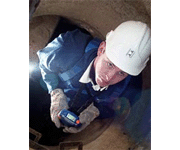

market@chinacoalintl.com
The last thing a worker in this environment needs to worry about is his or her gas detector. As we all know, working in confined spaces is difficult at the best of times. Operators often have to wear full PPE (personal protective equipment), are usually harnessed and may be carrying tools and equipment to complete the task in hand (e.g. welding). It should be designed specifically for confined space entry applications, be unobtrusive and have a clear display that is easy to see at a glance.
Any place, including any chamber, tank, vat, silo, pit, trench, pipe, sewer, flue, well or other similar space in which, by virtue of its enclosed nature, there arises a reasonably foreseeable risk’.
This definition covers just about any industrial activity but is especially applicable to the utilities industries (water and wastewater, electricity, telecommunications and gas), construction, hydrocarbon exploration and processing, petrochemicals, marine applications, agriculture, food processing, wine making and brewing, as well as emergency services.
Users of gas detectors have typically had to make a choice between large pumped units, small diffusion models, or models with ‘parasitic’ pumps, which are easily lost or damaged. Handheld detectors that measure a wider range of gases tend to have front-mount displays and are usually optimised for leak location or ‘hot work’ permit issue.
So, what are the requirements of the gas detector? The following five features to be essential:
Simple to use.
Bright, easy to read display.
Long battery life (for at least one full shift, and preferably two).
Robust construction.
Reliable detection

© Shandong China Coal Group. © 2017
Address: No. 11, North of Kaiyuan Road, High-tech Zone, Jining City, Shandong Province, China
sales@chinacoalintl.com
Executive Editor: Zhang Wen / Editor: Linda Zhang